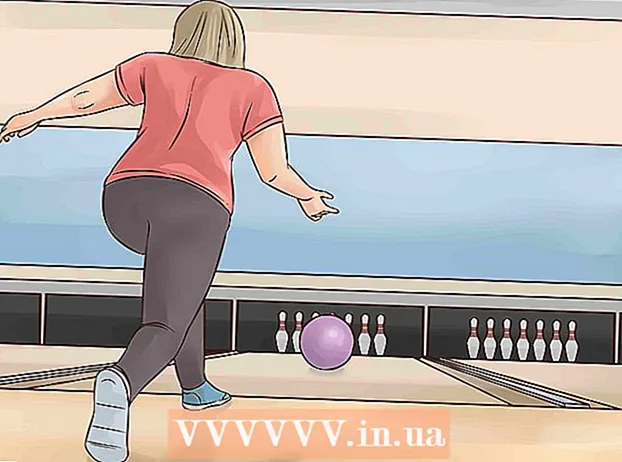Author:
Bobbie Johnson
Date Of Creation:
8 April 2021
Update Date:
1 July 2024

Content
- Steps
- Method 1 of 3: With cornstarch and vinegar
- Method 2 of 3: With gelatin or agar
- Method 3 of 3: Sculpting bioplastics
- Tips
- What do you need
Bioplastic is a type of plastic made from vegetable starch or gelatin / agar. It does not harm the environment as it is not made from petroleum products.Bioplastics can be made at home with a couple of simple ingredients and a stovetop!
Steps
Method 1 of 3: With cornstarch and vinegar
 1 Get everything you need ready. To prepare this type of bioplastic, you will need: cornstarch, distilled water, glycerin, white vinegar, a stove, a saucepan, a silicone spatula, and food coloring (if desired). All of these can be easily purchased at the grocery store or ordered online. Glycerin is sometimes called glycerol, so search by that name if you can't find glycerin. To make a bioplastic, you will need the following:
1 Get everything you need ready. To prepare this type of bioplastic, you will need: cornstarch, distilled water, glycerin, white vinegar, a stove, a saucepan, a silicone spatula, and food coloring (if desired). All of these can be easily purchased at the grocery store or ordered online. Glycerin is sometimes called glycerol, so search by that name if you can't find glycerin. To make a bioplastic, you will need the following: - 10 ml (2 teaspoons) distilled water
- 0.5-1.5 g (1 / 8-1 / 4 teaspoon) glycerin;
- 1.5 g (1/3 teaspoon) cornstarch
- 1 ml (1/5 teaspoon) white vinegar
- 1-2 drops of food coloring.
- We recommend that you do everything under the supervision of an adult.
 2 Combine all ingredients and mix well. Add all the ingredients to the saucepan and stir with a silicone spatula until there are almost no lumps left in the mixture. The mixture should turn milky white and runny.
2 Combine all ingredients and mix well. Add all the ingredients to the saucepan and stir with a silicone spatula until there are almost no lumps left in the mixture. The mixture should turn milky white and runny. - If you add the wrong amount of ingredients, simply discard the mixture and start over.
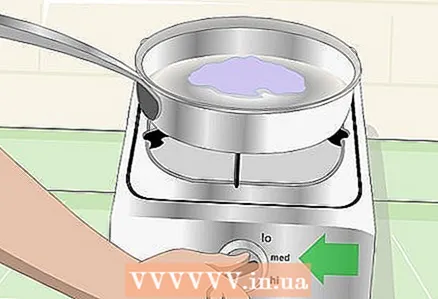 3 Heat the mixture over medium heat. Place the saucepan over medium heat. While the mixture is heating, stir it constantly. Bring the mixture to a boil. As the mixture warms up, it will become more transparent and begin to thicken.
3 Heat the mixture over medium heat. Place the saucepan over medium heat. While the mixture is heating, stir it constantly. Bring the mixture to a boil. As the mixture warms up, it will become more transparent and begin to thicken. - Remove the saucepan from the stove when the mixture is clear and thick.
- The total heating time is about 10-15 minutes.
- If the mixture overheats, it will begin to be taken in lumps.
- Add 1-2 drops of food coloring if you want to color the plastic.
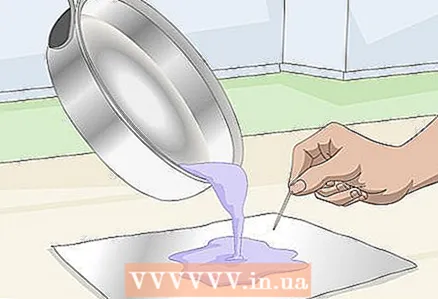 4 Pour the mixture onto foil or parchment paper. Spread the hot mixture over foil or paper to cool. If you want to sculpt a mold out of plastic, do it while it is still warm. Skip to the last method to learn how to mold a shape out of plastic.
4 Pour the mixture onto foil or parchment paper. Spread the hot mixture over foil or paper to cool. If you want to sculpt a mold out of plastic, do it while it is still warm. Skip to the last method to learn how to mold a shape out of plastic. - Remove any bubbles by piercing them with a toothpick.
 5 Leave the plastic to dry for at least two days. It takes time for the plastic to dry and harden. As it cools, the plastic will begin to dry out. Depending on the density of the plastic, it may take longer to dry. If you made one small but dense piece of plastic, it will take longer to dry than a large, thin piece.
5 Leave the plastic to dry for at least two days. It takes time for the plastic to dry and harden. As it cools, the plastic will begin to dry out. Depending on the density of the plastic, it may take longer to dry. If you made one small but dense piece of plastic, it will take longer to dry than a large, thin piece. - Leave the plastic to dry in a cool and dry place.
- Test the plastic after two days to see if it is completely cured.
Method 2 of 3: With gelatin or agar
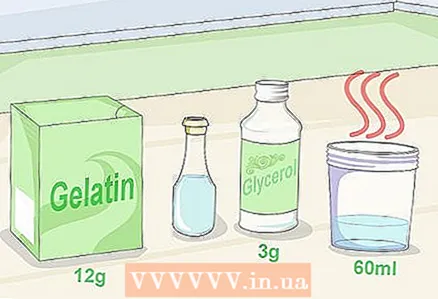 1 Get everything you need ready. For a recipe for this type of bioplastic, you will need: gelatin or agar-agar powder, glycerin, hot water, a saucepan, a stove, a silicone spatula and a pastry thermometer. All the ingredients you need can be easily purchased at your local grocery store. Remember that glycerin is sometimes called glycerol, so look under that name if you can't find glycerin. You will need the following ingredients:
1 Get everything you need ready. For a recipe for this type of bioplastic, you will need: gelatin or agar-agar powder, glycerin, hot water, a saucepan, a stove, a silicone spatula and a pastry thermometer. All the ingredients you need can be easily purchased at your local grocery store. Remember that glycerin is sometimes called glycerol, so look under that name if you can't find glycerin. You will need the following ingredients: - 3 g (half a teaspoon) glycerin;
- 12 g (3 teaspoons) gelatin or agar-agar;
- 60 ml (¼ cup) hot water
- food coloring (optional).
- Agar agar is an algae-derived substance that can replace gelatin and make vegan bioplastics.
 2 Mix all the ingredients together. Add all ingredients to the saucepan and stir until no lumps remain in the mixture. You may need to use a whisk to remove lumps from the mixture. Place the saucepan on the stove and start heating the mixture over medium heat.
2 Mix all the ingredients together. Add all ingredients to the saucepan and stir until no lumps remain in the mixture. You may need to use a whisk to remove lumps from the mixture. Place the saucepan on the stove and start heating the mixture over medium heat. - If you want to color the plastic, add a few drops of food coloring at this stage.
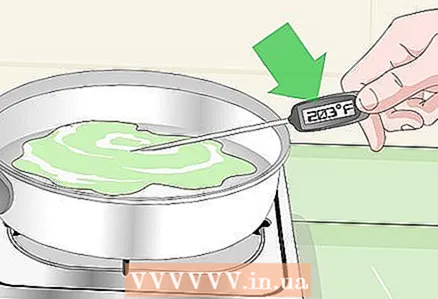 3 Heat the mixture to 95 ° C or until it foams. Insert a pastry thermometer into the mixture and wait until the inside temperature reaches 95 ° C or until the mixture foams.Don't worry if foam appears even before the mixture reaches the correct temperature. Remove the saucepan from heat when the mixture begins to foam or warms up to the desired temperature.
3 Heat the mixture to 95 ° C or until it foams. Insert a pastry thermometer into the mixture and wait until the inside temperature reaches 95 ° C or until the mixture foams.Don't worry if foam appears even before the mixture reaches the correct temperature. Remove the saucepan from heat when the mixture begins to foam or warms up to the desired temperature. - Continue stirring the mixture while it warms up.
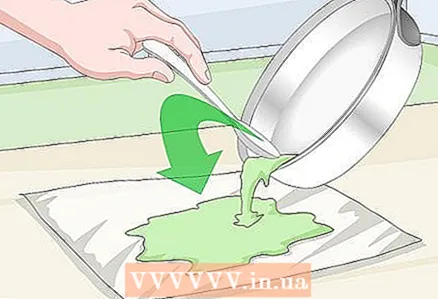 4 Pour the plastic onto a smooth surface covered with foil or parchment paper. Remove any foam after removing the saucepan from the heat. Spoon it away before pouring the plastic out of the saucepan. Stir everything well to remove any lumps from the plastic.
4 Pour the plastic onto a smooth surface covered with foil or parchment paper. Remove any foam after removing the saucepan from the heat. Spoon it away before pouring the plastic out of the saucepan. Stir everything well to remove any lumps from the plastic. - If you want to make bioplastics just for fun, pour the mixture onto a smooth surface. Remember to cover the surface with foil or parchment paper to make it easier to remove the plastic later.
- If you want to give the plastic a specific shape, you need to do it at this stage. Skip to the last method to learn how to shape the plastic.
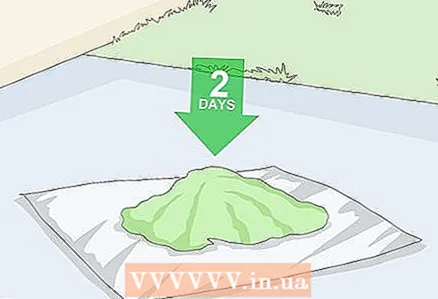 5 Leave the plastic on for two days to harden. The solidification rate of the plastic depends on the thickness of the piece. Typically, bioplastics need at least two days to completely dry and harden. This process can be sped up a little by blowing on the plastic with a hairdryer. Just leave the plastic alone for a few days to dry.
5 Leave the plastic on for two days to harden. The solidification rate of the plastic depends on the thickness of the piece. Typically, bioplastics need at least two days to completely dry and harden. This process can be sped up a little by blowing on the plastic with a hairdryer. Just leave the plastic alone for a few days to dry. - Once the plastic has hardened, it can no longer be shaped. If you want to sculpt something out of it, do it while it is still warm and pliable.
Method 3 of 3: Sculpting bioplastics
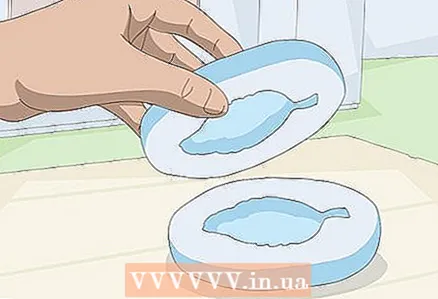 1 Prepare shape for plastic. Shape is the outline of the object you want to give to the plastic. To make a sample of an object that you want to reproduce, sculpt two pieces of clay around it. When the clay is dry, separate it from the object. If you fill the two halves with liquid plastic and then put them back together, you will receive a copy of this item. The cookie cutter can also cut different shapes from the plastic while still warm.
1 Prepare shape for plastic. Shape is the outline of the object you want to give to the plastic. To make a sample of an object that you want to reproduce, sculpt two pieces of clay around it. When the clay is dry, separate it from the object. If you fill the two halves with liquid plastic and then put them back together, you will receive a copy of this item. The cookie cutter can also cut different shapes from the plastic while still warm. - You can buy a ready-made mold at a craft store.
 2 Pour the hot plastic into a mold. Use a mold to craft items. Pour hot plastic into a mold. Make sure to fill it completely and remove any bubbles by lightly patting the shape.
2 Pour the hot plastic into a mold. Use a mold to craft items. Pour hot plastic into a mold. Make sure to fill it completely and remove any bubbles by lightly patting the shape. - To make it easier to reach an already frozen object, spray the mold with non-stick spray and only then fill it with plastic.
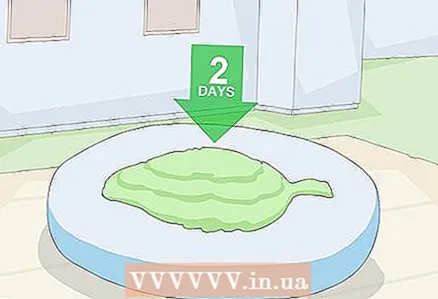 3 Wait two days for the plastic to dry. The plastic will take several days to dry and completely harden. The speed of solidification depends on the thickness of the object. If the item is very dense, then it can take more than two days to dry.
3 Wait two days for the plastic to dry. The plastic will take several days to dry and completely harden. The speed of solidification depends on the thickness of the object. If the item is very dense, then it can take more than two days to dry. - Test the plastic in two days. If it looks wet, leave it on for another day and then check it again. Check it from time to time until the plastic is completely dry.
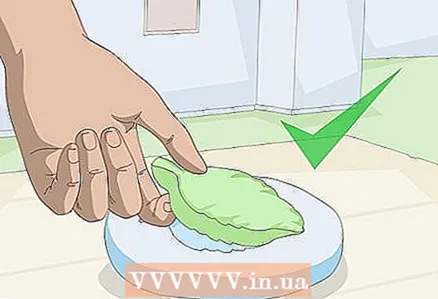 4 Remove the item from the mold. After a few days, the plastic should completely harden and dry. At this point, the plastic can be removed from the mold. You now have your own plastic version of the selected item.
4 Remove the item from the mold. After a few days, the plastic should completely harden and dry. At this point, the plastic can be removed from the mold. You now have your own plastic version of the selected item. - The mold can be reused to make as many copies of the item as needed.
Tips
- Add more glycerin to the recipe to make the item more elastic, or less glycerin to make it stiffer.
What do you need
With cornstarch and vinegar
- 10 ml (2 teaspoons) distilled vinegar
- 0.5-1.5 g (1 / 8-1 / 4 teaspoon) glycerin
- 1.5 g (1/3 teaspoon) cornstarch
- 1 ml (1/5 teaspoon) white vinegar
- 1-2 drops of food coloring
- Silicone spatula
- Non-stick saucepan
- Foil or parchment paper
With gelatin or agar-agar
- 3 g (1/2 teaspoon) glycerin
- 12 g (3 teaspoons) gelatin
- 60 ml (¼ cup) hot water
- Food coloring (optional)
- Silicone spatula
- Non-stick saucepan
- Foil or parchment paper
- Pastry thermometer


